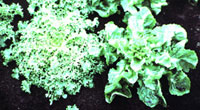Endive

Endive has been popular on the continent for a long time and is now being used more in this country. It provides a useful winter salad addition but has to be blanched before use to remove the very bitter taste.
Endive needs a sunny position and does best in soil that is rich and moisture retentive and a pH of 6.5.
3 weeks before sowing, apply a general fertiliser to the area, at the rate of 2oz per yard of row.
Sow the seed in late April or early May, directly where they are to grow. Do not be tempted to sow too early as the plants have a tendency to run to seed. Sow the seed thinly in shallow drills and thin the plants to 9" apart. Leave 12" between the rows.
Keep the plants free of weeds and well watered. Ensure that they are kept well watered or they will run to seed.

12 weeks after sowing the seed, the plants should be ready to start blanching. Choose a few plants and ensuring that the leaves are dry; tie the leaves into a bunch with coarse string or raffia. Cover with a large plastic plantpot or bucket. If using a plantpot, don't forget to cover the holes in the bottom, as all light must be excluded. The heads will be ready for use after 3 weeks during the summer or 5 weeks in the winter. It is advisable to use slug deterrents, as the tender young leaves are an open invitation to slugs.
Pests and Diseases
Endive is a trouble free plant but slugs can be a problem or, on rare occasions you may find a few Aphids. (See relative Pests and Diseases section)
© copyright 1999, P. A. Owen

